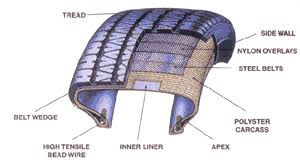A tubeless tire is a tire that does not require an inner tube. It has no inner tube, so it is called tubeless. Tubeless tires are commonly used on mountain bikes and other off-road bicycles, as well as motorbikes and some cars.
The tire is held in place by the wheel rim. The rim forms an airtight seal with the bead of the tire to prevent leakage between the rim and the bead when inflated.
Tubeless tires are not limited to bicycles; they are also used on cars, motorcycles, and airplanes.
Tubeless tires use air pressure to inflate a tire.
If you’ve been on the fence about whether tubeless tires are for you, there’s no better time to decide. It’s as easy as breathing—literally! Tubeless tires use air pressure to inflate a tire just like a regular tube, except that instead of being held in place by the inner walls of a tube, it’s contained in the casing of the tire and wall of the rim. To ensure that the air stays in place despite sharp rocks or other debris that can puncture a tube, tubeless tires make use of sealant to patch up small holes before they can expand into an unsalvageable gash.
In order for this sweet-yet-simple magic trick to work its wonders on your bike, three main ingredients are required: an airtight tire casing, a valve stem set at the appropriate angle and length for your rim, and sealant made from liquid latex. The last piece is especially important because it acts as a buffer against punctures by using air pressure to plug any tears before they can do serious damage.
But they differ from traditional tires because they don’t rely on an inner tube.
Tubeless tires work in the same way as traditional tires, but they differ from traditional tires because they don’t rely on an inner tube.
On a tubeless tire, there is a molded ridge that runs around the inside edge of the wheel rim. The tire bead rests on this ridge and must be airtight to prevent pressure loss. This allows the tire to be inflated directly without an inner tube sealing off all of the gaps in between.
The valve connects to the rim, which has been modified to have an airtight base that can be sealed when inflated.
To inflate the tire, you fit a pump over the valve and pressurize the air chamber. There are two main types of valves: Presta and Schrader. The latter is the same as that used on car tires; it has a valve similar to a bicycle tube’s, but it’s larger in diameter and has a spring-loaded pin in its core. A specialized tool allows you to press down on this pin and thus deflate the tire as well as seal it when you’ve inserted the tube inside.
Valves can be short or long with different diameters, depending on their applications
A liquid sealant is applied inside the tire and acts as a barrier against punctures.
- Before you mount the tire, apply a liquid sealant inside it.
- The sealant acts as a barrier that prevents air from escaping in the case of a puncture.
- Apply it through the valve stem, making sure that you follow the manufacturer’s recommendation on how much to use.
- Sealant will work best when applied according to guidelines provided by its manufacturer.”
As you drive, your vehicle’s weight keeps the tire pressed against the wheel.
Because there is no inner tube, a tubeless tire needs to seal itself against the wheel. Because you have to fill the tire with air before you can use it, it is necessary for the seal to be airtight. The weight of your vehicle keeps the tire pressed against the wheel, creating an airtight connection when you inflate the tire. Once your valve is attached to your rim, simply pump in some air and sealant through the valve stem and feel confident that your tires will not go flat while you’re driving.
Tubeless tires create an airtight seal around the wheel
Tubeless tires work by forming an airtight seal around the tire so that a tube is not needed. Much like you might use a sealant to patch a hole on the side of your boat, tubeless tires communicate with the rim to ensure that no air escapes (and thus, your tire stays inflated).
The process of creating this seal involves two components: the tire and the tubeless-compatible wheel. The inside of the tire has been coated with a rubber compound that sticks to any rim that is also coated with this rubber compound. Additionally, there are ridges on both surfaces which help them lock together. When you mount your tire onto your wheel and inflate it, these ridges push one another flat against each other and create an airtight seal.


